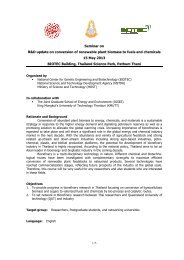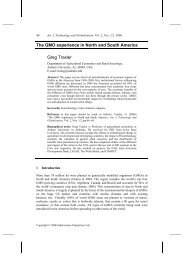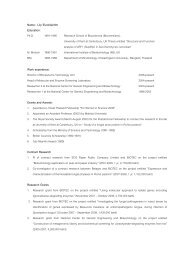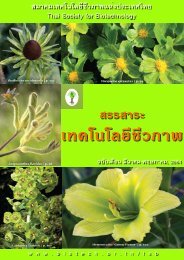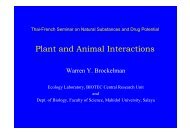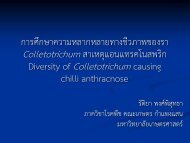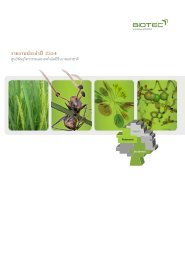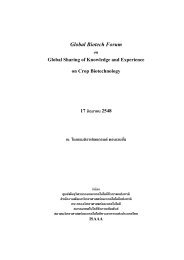Dr. Gurdev Singh Khush
Dr. Gurdev Singh Khush
Dr. Gurdev Singh Khush
You also want an ePaper? Increase the reach of your titles
YUMPU automatically turns print PDFs into web optimized ePapers that Google loves.
Golden Sickle Award 2007<br />
<strong>Dr</strong>. <strong>Gurdev</strong> <strong>Singh</strong> <strong>Khush</strong><br />
<strong>Dr</strong>. <strong>Gurdev</strong> <strong>Singh</strong> <strong>Khush</strong>, one of the heroes<br />
of green revolution, was raised on a small<br />
farm in Punjab, India. He received B.Sc.<br />
degree from Punjab Agricultural University<br />
in 1955 and Ph.D. in 1960 from the University<br />
of California, Davis. After serving as a<br />
faculty member of the University of California<br />
for seven years, he joined International Rice<br />
Research Institute (IRRI) in the Philippines<br />
as Plant Breeder, and was appointed a Head<br />
of Plant Breeding Department in 1972. He<br />
<strong>Dr</strong>. <strong>Khush</strong> has made outstanding contributions<br />
to advancing the frontiers of rice genetics.<br />
He has trained numerous plant breeders and<br />
served as consultant to several national rice<br />
improvement programs.<br />
retired in February 2002 as Principal<br />
Plant Breeder and Head of Division of Plant<br />
Breeding Genetics and Biochemistry. During<br />
his 35 year career at IRRI he spearheaded<br />
the program for developing high yielding,<br />
disease and insect resistant and short<br />
duration varieties of rice which ushered<br />
in green revolution in rice farming. These<br />
varieties and their progenies are now<br />
planted to about 60% of world’s rice land<br />
resulting in food security, environmental<br />
sustainability, political stability and prosperity<br />
For his contribution to food security <strong>Dr</strong>.<br />
<strong>Khush</strong> received Japan Prize in 1987, World<br />
Food Prize in 1996, Rank Prize in 1998<br />
and Wolf Prize in Agriculture in 2000. He<br />
received honorary doctorate degrees from<br />
ten universities, the latest being from Ohio<br />
State University. <strong>Dr</strong>. <strong>Khush</strong> was elected to<br />
the Indian National Science Academy, Third<br />
World Academy of Sciences, U.S. National<br />
Academy of Sciences and Royal Society of<br />
London.<br />
particularly in Asia<br />
www.biotec.or.th
<strong>Dr</strong>. <strong>Gurdev</strong> <strong>Singh</strong> <strong>Khush</strong> and his team developed<br />
over 300 rice varieties, including IR36, IR64<br />
and IR72, which triggered the Green Revolution<br />
in Asia in the 1970s.<br />
According to IRRI estimates, IR36 added about<br />
5 million tonnes of rice annually to Asia’s food<br />
supply accounting for an additional $1 billion<br />
yearly income to Asian farmers. IR64 later<br />
replaced IR36 as the world’s most popular<br />
IR36, known as “Miracle Rice”, was developed<br />
using IR8 as a genetic base and cross<br />
breeding it with 13 parent varieties from<br />
six nations. IR36 is a semi-dwarf variety<br />
variety during 1990s. It has all the good<br />
attributes of IR36 and in addition has highly<br />
palatable grains. IR72, released in 1990, is<br />
world’s highest-yielding rice variety.<br />
with high yield potential and resistance to a<br />
number of the major insect pests and diseases.<br />
It matures in about 110 days compared to 130<br />
days for IR8 and 150-170 days for traditional<br />
rice varieties. It has slender and translucent<br />
grains preferred in many Asian countries. The<br />
combination of these desirable characteristics<br />
soon made IR36 one of the most widely planted<br />
food crop varieties the world has ever known.<br />
It was planted to about 11 million hectares or<br />
25 million acres of rice land during 1980s.<br />
In 1994, <strong>Dr</strong>. <strong>Khush</strong> announced the development<br />
of New Plant Type (NPT) popularly know<br />
as “super rice”, which has the potential to<br />
increase yields by 15 percent. After 12 years<br />
of painstaking work <strong>Dr</strong>. <strong>Khush</strong> and his team<br />
has developed numerous breeding lines of<br />
NPT. Several NPT lined have been released as<br />
varieties in China, Indonesia and Philippines.<br />
Other countries are doing further breeding<br />
work with NTP.



